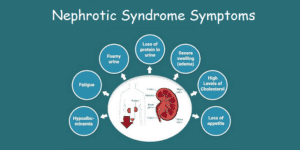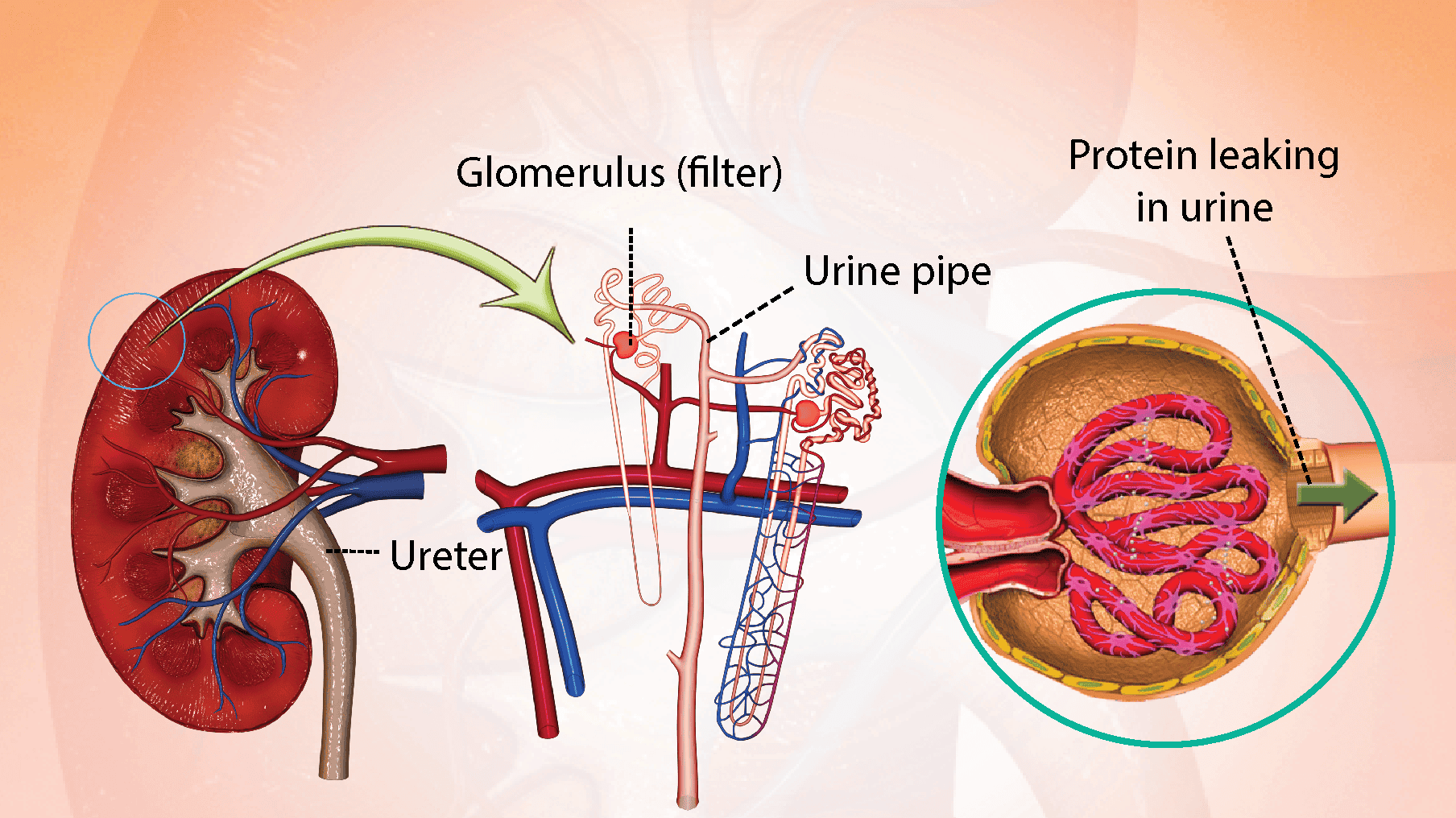Today we are going to unfold the difference between nephrotic and nephritic syndromes. The key difference between nephrotic and nephritic syndrome is that in nephrotic syndrome excess amounts of proteins are lost in the urine, whereas in nephritic syndrome, an excess amount of blood is lost in the urine. In short, we can say that Nephrotic syndrome is related to Proteins; and the nephritic syndrome is related to blood loss in urine.

Nephrotic Syndrome Signs And Symptoms
Patients with nephrotic syndrome will have:
- Edema
- Hypoalbuminemia
- Hyperlipidemia
- Proteinuria
There are several comorbidities associated with nephrotic syndrome, with the two most common being type 2 diabetes and lupus.

Nephrotic Syndrome Diagnosis
The diagnostic criterion of the nephrotic syndrome includes:
- Loss of proteins in urine
- edema
- hypoalbuminemia
- hyperlipidemia

Nephrotic Syndrome Complications
Regarding the treatment of nephrotic syndrome, one way is to try to avoid complications that can occur due to nephrotic syndrome. Some potential complications include venous thrombosis, hyperlipidemia, and infection. Edema patients are usually started on diuretics, such as furosemide and other loop diuretics. Each patient is evaluated independently regarding the increased risk of venous thrombosis. Patients with a higher risk of venous thrombosis could be started on anticoagulation medicines; however, the bleeding risk could outweigh the risk of thrombosis.
For treating proteinuria, usually, ACE inhibitors or ARBs are recommended due to their known reverse effects on proteinuria. Immunosuppressive therapies are also suggested to some, like corticosteroids, adrenocorticotropic hormone, etc.
Nephrotic Syndrome
Next, we will discuss nephritic syndrome. This is a disease in which there is damage to the glomerulus that leads to hematuria, water retention, and dysuria, which leads to hypertension and edema. The various other things associated with the nephritic syndrome include hereditary, autoimmune, and infectious etiologies.
The list of possible causes of nephritic is frightening. This could range from glomerulonephritis, IgA nephropathy, Wegener’s disease, Alport syndrome, Lupus nephritis, etc.

Nephrotic Syndrome Diagnosis
Patients suffering from nephritic syndrome will complain of intermittent gross hematuria, or the classic “coca cola” colored urine. In addition to the hematuria patients will also have hypertension, lower extremity edema, decreased GFR, and potentially oliguria.
The diagnosis of nephritic syndrome is largely based on microscopic urinalysis. On testing, red blood cells will be identified in either small (microhematuria) or large amounts (macrohematuria). Additionally, dysmorphic red blood cells known as spur cells or acanthocytes may be seen microscopically.
Upon identification of nephritic syndrome, the next step is attempting to find the underlying etiology.
Nephrotic Syndrome Treatment
At first, the treatment for nephritic syndrome is treated with supportive care including a low-sodium diet and water restriction. Treatment additionally includes treatment of associated issues.

How Ayurveda is helping in nephritic and nephrotic syndrome?
More than 4,000 years ago, in India, ayurveda was developed. The words “ayur” (life) and “veda,” which are from Sanskrit, were combined to form the phrase “ayurveda” (science or knowledge of life). As a result, Ayurveda teaches us about life. According to Ayurveda, any illness in the body results from an imbalance or tension in the individual’s consciousness. Ayurveda promotes particular lifestyle changes and treatments. The body, mind, spirit, and surroundings can all be brought back into harmony with the use of these treatments.
An internal cleansing process is the first step in ayurvedic kidney treatment. A unique diet, a few herbal treatments, and, if necessary, some particular massage therapy, yoga, and meditations are then recommended.
Nephrotic Syndrome Ayurvedic Treatments aims to purify the body, heal symptoms, and then boost resistance to illness. It also seeks to make life more peaceful and less stressful. It uses plants, including herbs, for these procedures. Ayurveda begins by comprehending the causes of the condition. Patients with kidney illnesses have been observed to have altered Agni. Food cannot be properly digested because of this disturbed Agni, and “ama” is produced as a result. Disturbed Agni is a result of a manner of life that pulls us away from nature, the consumption of unnatural foods, the use of tobacco and alcohol, and engrossing stress.

Vata, Pitta And Kapha Dosha – Nephrotic Syndrome
Ayurveda assesses any disease in terms of Dosha, Dushya, and Adhishthana of the disease and the capabilities of the patient. After proper identification, appropriate therapeutic interventions are planned. The contemporary system of treatment is costly. There is always a need to establish affordable medical care with no side effects. Our ancient system of treatment-ayurveda is available with sustainable remedial measures. When we try to understand kidney disease as per the view of Ayurveda, we find that for all types of urine disorders, Vata dosha is the causative factor collaborating with Pitta and Kapha. The proportion of vata, pitta and Kapha dosha varies from person to person. Hence, a person-specific treatment needs to be applied considering Doshas. A general proposed line of kidney failure treatment is virechana.
Any illness is evaluated by Ayurveda in terms of the patient’s capabilities, the disease’s Dosha, Dushya, and Adhishthana. Suitable therapy approaches are planned after accurate identification. The current medical system is expensive. Establishing cost-effective, effect-free medical treatment is always necessary. Ayurveda, our traditional medical system, has sustainable therapeutic options. When we try to explain kidney disease from the perspective of Ayurveda, we find that Vata dosha is the primary cause, working in conjunction with Pitta and Kapha. Everybody has a different ratio of vata, pitta to kapha dosha. So, taking into account Doshas, a treatment tailored to the individual is required. Virechana, swedana, mutrapravartaka, raktaprasadaka, agni deepan etc are often advised in the course of treatment for kidney failure.

Ayurvedic Medications Nephrotic Syndrome
In ayurveda, there is an idea of compatibles and incompatibles known as pathya-apathyas. Regenerating herbs are part of the Rasayana Chikitsa category of Ayurvedic medications, which aid in nephron regeneration.
Kidney ailments, or Mutravaha strotosdushti, are primarily treated in Ayurveda with Basti (Enema therapy). A medicated detox therapy is an enema. It is injected through the urinary system and works to remove poisons that have built up. Additionally, this gets rid of the exacerbated doshas that can be the root of kidney problems.
Although there are many herbs and herbal medicines used to repair kidney damage, a few among those are Punarnavadi Guggulu, Gokshuadi Guggulu, Chandraprabha Vati, etc. Ayurveda also prescribes disease-specific diet (Ahaar) and lifestyle (Vihaar) changes. These are recommended by Ayurvedic experts to combat kidney disease.
It is always advised to consult an ayurvedic practitioner before consuming any herbs for treatment.

